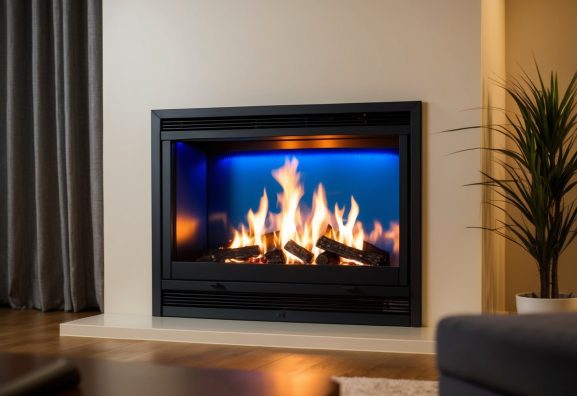Gas vs Electric Fireplace: Which Is Better?
When considering the cozy comfort of a fireplace, the choice between gas and electric options can be somewhat of a debate. Each type boasts unique benefits, making them both worthy contenders in home heating. Gas fireplaces offer a natural flame and heat quickly, making them ideal for those who prioritize warmth and ambiance.
Electric fireplaces, on the other hand, excel in energy efficiency and ease of installation, requiring no venting or complex setup. They serve as a functional and stylish solution for those who may face higher installation costs with gas models. The convenience and minimal maintenance of electric fireplaces can be appealing, particularly in homes without an existing gas line.
Both options have their place in enhancing a home’s atmosphere and functionality. By weighing factors like installation ease, energy efficiency, and aesthetic appeal, the decision becomes clearer, assisting homeowners in making an informed choice that suits their lifestyle and preferences.
Key Takeaways
- Gas fireplaces provide natural flames and quickly heat spaces.
- Electric models prioritize energy efficiency and simplicity in installation.
- Consider installation, efficiency, and aesthetics when choosing.
Comparing Gas and Electric Fireplaces

When determining whether to choose a gas or electric fireplace, factors like lifespan, installation cost, and energy efficiency play significant roles. Gas fireplaces offer a real flame and greater heat output, while electric ones provide flexibility and cost-effectiveness in different settings.
Overview and Core Differences
Gas fireplaces utilize natural gas or propane to produce heat, creating a traditional flame atmosphere that many homeowners appreciate. They often require a gas line and ventilation system, making installation more complex and costly. In contrast, electric fireplaces are simpler to install, often requiring just a standard electrical outlet, and are more energy-efficient by converting electricity directly into heat.
While gas fireplaces need regular maintenance to ensure safe operation due to carbon monoxide emissions, electric models only require occasional cleaning of the exterior. Gas units generally last longer, but electric fireplaces have lower operational costs and no emissions, offering an eco-friendly alternative. The choice between the two often hinges on installation feasibility and long-term cost considerations.
Appearance and Aesthetics
Aesthetic preferences can significantly influence the decision. Gas fireplaces provide a more realistic flame effect, closely mimicking that of a traditional wood-burning fireplace. This creates a warm, inviting atmosphere with authentic sounds and flickering light that some find irreplaceable.
Electric fireplaces, on the other hand, use LED lighting and flame effects to simulate a fire. While not entirely authentic, these features can be adjusted in terms of color and brightness, offering flexibility that gas models do not. They can fit various interior styles and settings, appealing to those who prefer a more modern look. The choice depends on whether one values the natural appearance of a real flame or the versatility of customizable effects.
Installation and Setup Requirements

Choosing between a gas and electric fireplace involves understanding the installation complexities and utility requirements for each option. Factors such as the need for a gas line or electrical changes can affect the overall installation process and impact costs.
Installation Process
Gas Fireplaces often require professional installation due to the complexity of fitting a gas line and venting systems. Built-in units might necessitate structural modifications, whereas ventless gas fireplaces offer more flexibility. Costs can be higher due to labor and materials.
Electric Fireplaces are generally easier to install. Electric fireplace inserts and wall-mounted units usually only need a standard household outlet, allowing DIY installation with minimal effort. They don’t need venting, making them more adaptable in different room setups and configurations.
Utilities and Power Supply
Gas fireplaces need a reliable propane supply or connection to a natural gas line. This setup can offer consistent heating but requires careful monitoring and maintenance for safety.
Electric fireplaces rely on the electrical system in the home. They require sufficient power capacity to handle the fireplace load, with units often needing a dedicated circuit. This could involve electrical upgrades, especially in older homes where existing systems might be insufficient.
Operation and Maintenance

Both gas and electric fireplaces offer unique operational and maintenance aspects. Gas fireplaces often require more careful handling, whereas electric models are generally more straightforward and need less upkeep.
Ease of Use
Electric fireplaces are often praised for their simplicity. They can be operated with a remote or a switch and do not need a chimney, vent, or gas line. Homeowners can enjoy the warmth without dealing with smoke or soot.
Gas fireplaces, while more complex, offer a realistic flame and greater heat output. They’ll need gas line installation and regular checks for leaks. Switching them on and off requires manual control or a remote. These units provide a cozy ambiance but demand a bit more attention during operation.
Routine Maintenance
Routine maintenance varies significantly between gas and electric fireplaces. Electric models have low maintenance requirements due to their clean-burning nature. Cleaning the glass facade occasionally is usually sufficient.
Gas fireplaces demand more upkeep. They should be inspected for gas leaks, and the flue and chimney require annual cleaning to prevent soot buildup. Gas valve checks are essential to ensure safety. More frequent maintenance will ensure the efficient and safe operation of gas fireplaces over time.
Safety and Environmental Impact

When comparing gas and electric fireplaces, it’s important to consider both safety features and potential environmental impacts. Gas fireplaces require caution due to combustion byproducts, whereas electric models offer cleaner operation but depend on energy sources with varying degrees of carbon output.
Health and Safety Considerations
Gas fireplaces emit carbon monoxide, a potentially dangerous gas. It is essential to ensure proper ventilation and install a carbon monoxide detector for safety. Inadequate ventilation poses risks to health due to the build-up of combustion gases.
Electric fireplaces, on the other hand, do not emit carbon monoxide or any other combustion byproducts. This makes them safer for indoor air quality. However, caution should still be exercised to prevent electrical hazards. Both types require attention to surrounding materials to reduce fire risks.
Creosote accumulation, a safety concern specific to wood-burning units, is not an issue for gas or electric fireplaces. Creosote can lead to chimney fires if not regularly cleaned, but gas and electric models eliminate this risk.
Ecological Footprint
Gas fireplaces release carbon dioxide and other emissions into the atmosphere, contributing to greenhouse gas accumulation. They burn natural gas or propane, both of which have environmental impacts due to extraction and fuel combustion processes.
Electric fireplaces offer an appealing alternative in terms of localized emissions. However, their ecological impact largely hinges on the electricity source. If the electric grid relies heavily on fossil fuels, emissions are transferred to power plants rather than eliminated.
Using renewable energy significantly reduces the environmental footprint of electric fireplaces, making them a more sustainable choice if available. Ventless gas models may seem efficient, but they still contribute to indoor pollutants if not used with adequate ventilation.
Costs and Energy Efficiency

When comparing gas and electric fireplaces, both cost considerations and energy efficiency play key roles. Gas fireplaces often have higher installation and fuel costs, while electric models are generally more affordable upfront and during operation. Additionally, electric fireplaces tend to be more energy-efficient, converting nearly all energy into heat.
Initial and Operating Costs
The initial costs of a gas fireplace typically involve higher expenses. Installation costs can be substantial due to venting requirements and gas line installations. In contrast, electric fireplaces usually range from $250 to $1,000, making them more budget-friendly at the outset.
Operating costs differ between the two. Gas fireplaces incur ongoing costs for propane or natural gas. Depending on usage, they may run between $200 to $500 annually. Electric fireplaces, in general, have annual operating costs ranging from $50 to $80, primarily consisting of electricity usage. However, if electrical modifications are necessary, initial setup costs could rise.
Energy Consumption and Heat Output
Electric fireplaces excel in energy efficiency, converting nearly 100% of electricity into heat. This maximizes efficiency, particularly in smaller spaces. Meanwhile, gas fireplaces convert about 70% to 90% of their energy into heat, making them effective but less efficient than electric.
In terms of heat output, gas fireplaces produce more BTUs and can better warm larger areas. Electric fireplaces generate radiant heat, suitable for zone heating. For instance, dual-sided electric models may enhance heat output but at increased cost. Overall, the choice between gas and electric depends on individual needs for space heating and efficiency.
Long-Term Considerations

Choosing between a gas and an electric fireplace involves evaluating factors such as durability, lifespan, and potential impact on home resale value and upgrades. These considerations can significantly influence the right choice for a homeowner.
Durability and Lifespan
Gas fireplaces generally have a longer lifespan compared to electric fireplaces. Constructed often from durable materials, they can last for 10 to 15 years with proper maintenance. Regular inspections of gas lines and vents are essential to ensure safety and longevity. Both propane and natural gas are viable fuel sources, impacting the durability based on availability and installation quality.
Electric fireplaces, on the other hand, have fewer mechanical components and tend to experience less wear and tear. Their lifespan is generally around 10 years. Because they are predominantly electrical devices, issues such as power outages can temporarily affect their operation. Maintenance is minimal, often only requiring occasional dusting and ensuring the electrical connections stay secure.
Resale Value and Upgrades
Having a gas fireplace can enhance a home’s resale value more significantly than an electric one. Homebuyers often perceive gas fireplaces as more desirable due to their authentic flame and heating capacity. The need for a propane tank or natural gas line adds initial installation costs but also enhances the feature’s perceived value.
Electric fireplaces offer flexibility in terms of upgrades and aesthetics. They typically provide a modern look and are less costly to install or modify. Despite this, they generally contribute less to home resale value compared to gas models. Their ease of integration into various home styles can appeal to buyers looking for fewer installation challenges.
Frequently Asked Questions
This section addresses common inquiries about gas and electric fireplaces. It covers aspects such as performance, installation, running costs, and the effect on resale value.
What are the pros and cons of gas versus electric fireplaces?
Gas fireplaces offer higher heat output and a more authentic flame appearance. They require gas supply lines and may need venting. Electric fireplaces are more affordable to install and maintain, providing easier installation and no emissions, though they have lower heat output compared to gas options.
How do gas and electric fireplace inserts differ in performance and installation?
Gas inserts produce real flames and can heat larger spaces efficiently, but they may need a chimney or venting system. Electric inserts provide a simulated flame effect and are easier to install due to their plug-and-play nature. They are ideal for smaller spaces and do not require venting.
What is the impact on resale value when choosing a gas versus electric fireplace?
Gas fireplaces may enhance a home’s resale value more significantly because they are viewed as a permanent, efficient heating option. Electric fireplaces are appreciated for their convenience and low cost, but they may not add as much to resale value due to their perception as being less substantial.
How do the running costs compare between gas fireplaces and electric heaters?
Running costs for gas fireplaces can vary based on local gas prices and usage levels but are generally higher than electric heaters. Electric fireplaces, while cheaper to operate, may consume more electricity over time depending on usage patterns and electricity rates.
What are the heating efficiency differences between electric and gas fireplaces?
Gas fireplaces generally have higher heating efficiency and are more suitable for larger rooms. They can quickly increase a room’s temperature. Electric fireplaces are less efficient in terms of heat output, providing localized heating that is best suited for smaller or supplementary spaces.
Can an electric fireplace be a suitable replacement for a gas fireplace?
An electric fireplace can replace a gas fireplace in situations where installation simplicity, low maintenance, and cost are priorities. While they offer ease of use and aesthetic appeal, they may not provide the same level of heat output as gas fireplaces, making them more suitable for decorative purposes or mild climates.


